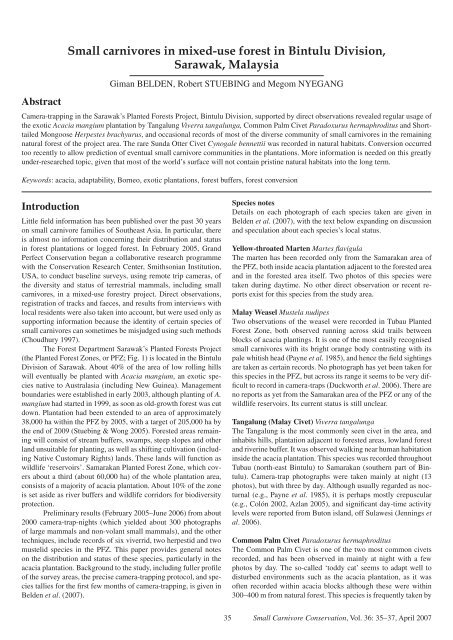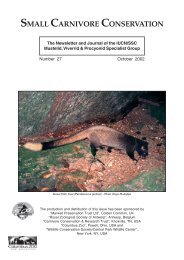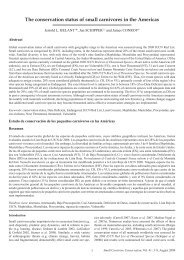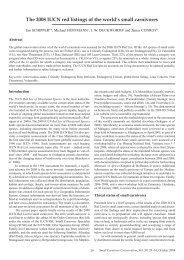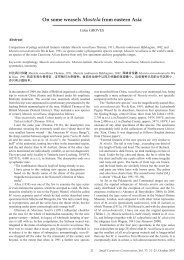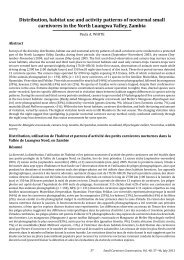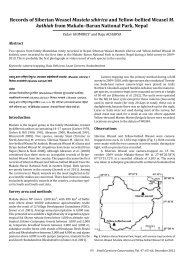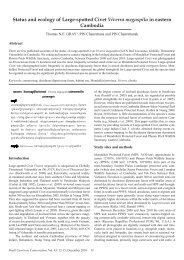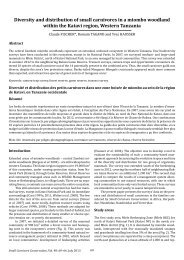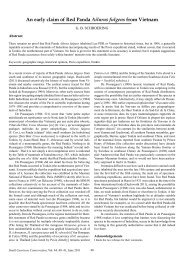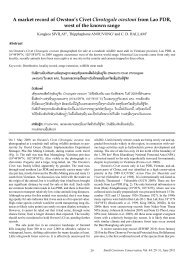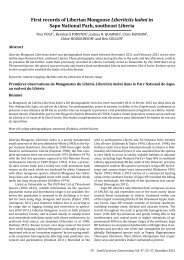Small carnivores in mixed-use forest in Bintulu Division, Sarawak ...
Small carnivores in mixed-use forest in Bintulu Division, Sarawak ...
Small carnivores in mixed-use forest in Bintulu Division, Sarawak ...
You also want an ePaper? Increase the reach of your titles
YUMPU automatically turns print PDFs into web optimized ePapers that Google loves.
Abstract<br />
<strong>Small</strong> <strong>carnivores</strong> <strong>in</strong> <strong>mixed</strong>-<strong>use</strong> <strong>forest</strong> <strong>in</strong> B<strong>in</strong>tulu <strong>Division</strong>,<br />
<strong>Sarawak</strong>, Malaysia<br />
Giman BELDEN, Robert STUEBING and Megom NYEGANG<br />
Camera-trapp<strong>in</strong>g <strong>in</strong> the <strong>Sarawak</strong>’s Planted Forests Project, B<strong>in</strong>tulu <strong>Division</strong>, supported by direct observations revealed regular usage of<br />
the exotic Acacia mangium plantation by Tangalung Viverra tangalunga, Common Palm Civet Paradoxurus hermaphroditus and Shorttailed<br />
Mongoose Herpestes brachyurus, and occasional records of most of the diverse community of small <strong>carnivores</strong> <strong>in</strong> the rema<strong>in</strong><strong>in</strong>g<br />
natural <strong>forest</strong> of the project area. The rare Sunda Otter Civet Cynogale bennettii was recorded <strong>in</strong> natural habitats. Conversion occurred<br />
too recently to allow prediction of eventual small carnivore communities <strong>in</strong> the plantations. More <strong>in</strong>formation is needed on this greatly<br />
under-researched topic, given that most of the world’s surface will not conta<strong>in</strong> prist<strong>in</strong>e natural habitats <strong>in</strong>to the long term.<br />
Keywords: acacia, adaptability, Borneo, exotic plantations, <strong>forest</strong> buffers, <strong>forest</strong> conversion<br />
Introduction<br />
Little field <strong>in</strong>formation has been published over the past 30 years<br />
on small carnivore families of Southeast Asia. In particular, there<br />
is almost no <strong>in</strong>formation concern<strong>in</strong>g their distribution and status<br />
<strong>in</strong> <strong>forest</strong> plantations or logged <strong>forest</strong>. In February 2005, Grand<br />
Perfect Conservation began a collaborative research programme<br />
with the Conservation Research Center, Smithsonian Institution,<br />
USA, to conduct basel<strong>in</strong>e surveys, us<strong>in</strong>g remote trip cameras, of<br />
the diversity and status of terrestrial mammals, <strong>in</strong>clud<strong>in</strong>g small<br />
<strong>carnivores</strong>, <strong>in</strong> a <strong>mixed</strong>-<strong>use</strong> <strong>forest</strong>ry project. Direct observations,<br />
registration of tracks and faeces, and results from <strong>in</strong>terviews with<br />
local residents were also taken <strong>in</strong>to account, but were <strong>use</strong>d only as<br />
support<strong>in</strong>g <strong>in</strong>formation beca<strong>use</strong> the identity of certa<strong>in</strong> species of<br />
small <strong>carnivores</strong> can sometimes be misjudged us<strong>in</strong>g such methods<br />
(Choudhury 1997).<br />
The Forest Department <strong>Sarawak</strong>’s Planted Forests Project<br />
(the Planted Forest Zones, or PFZ; Fig. 1) is located <strong>in</strong> the B<strong>in</strong>tulu<br />
<strong>Division</strong> of <strong>Sarawak</strong>. About 40% of the area of low roll<strong>in</strong>g hills<br />
will eventually be planted with Acacia mangium, an exotic species<br />
native to Australasia (<strong>in</strong>clud<strong>in</strong>g New Gu<strong>in</strong>ea). Management<br />
boundaries were established <strong>in</strong> early 2003, although plant<strong>in</strong>g of A.<br />
mangium had started <strong>in</strong> 1999, as soon as old-growth <strong>forest</strong> was cut<br />
down. Plantation had been extended to an area of approximately<br />
38,000 ha with<strong>in</strong> the PFZ by 2005, with a target of 205,000 ha by<br />
the end of 2009 (Stueb<strong>in</strong>g & Wong 2005). Forested areas rema<strong>in</strong><strong>in</strong>g<br />
will consist of stream buffers, swamps, steep slopes and other<br />
land unsuitable for plant<strong>in</strong>g, as well as shift<strong>in</strong>g cultivation (<strong>in</strong>clud<strong>in</strong>g<br />
Native Customary Rights) lands. These lands will function as<br />
wildlife ‘reservoirs’. Samarakan Planted Forest Zone, which covers<br />
about a third (about 60,000 ha) of the whole plantation area,<br />
consists of a majority of acacia plantation. About 10% of the zone<br />
is set aside as river buffers and wildlife corridors for biodiversity<br />
protection.<br />
Prelim<strong>in</strong>ary results (February 2005–June 2006) from about<br />
2000 camera-trap-nights (which yielded about 300 photographs<br />
of large mammals and non-volant small mammals), and the other<br />
techniques, <strong>in</strong>clude records of six viverrid, two herpestid and two<br />
mustelid species <strong>in</strong> the PFZ. This paper provides general notes<br />
on the distribution and status of these species, particularly <strong>in</strong> the<br />
acacia plantation. Background to the study, <strong>in</strong>clud<strong>in</strong>g fuller profile<br />
of the survey areas, the precise camera-trapp<strong>in</strong>g protocol, and species<br />
tallies for the first few months of camera-trapp<strong>in</strong>g, is given <strong>in</strong><br />
Belden et al. (2007).<br />
Species notes<br />
Details on each photograph of each species taken are given <strong>in</strong><br />
Belden et al. (2007), with the text below expand<strong>in</strong>g on discussion<br />
and speculation about each species’s local status.<br />
Yellow-throated Marten Martes fl avigula<br />
The marten has been recorded only from the Samarakan area of<br />
the PFZ, both <strong>in</strong>side acacia plantation adjacent to the <strong>forest</strong>ed area<br />
and <strong>in</strong> the <strong>forest</strong>ed area itself. Two photos of this species were<br />
taken dur<strong>in</strong>g daytime. No other direct observation or recent reports<br />
exist for this species from the study area.<br />
Malay Weasel Mustela nudipes<br />
Two observations of the weasel were recorded <strong>in</strong> Tubau Planted<br />
Forest Zone, both observed runn<strong>in</strong>g across skid trails between<br />
blocks of acacia plant<strong>in</strong>gs. It is one of the most easily recognised<br />
small <strong>carnivores</strong> with its bright orange body contrast<strong>in</strong>g with its<br />
pale whitish head (Payne et al. 1985), and hence the field sight<strong>in</strong>gs<br />
are taken as certa<strong>in</strong> records. No photograph has yet been taken for<br />
this species <strong>in</strong> the PFZ, but across its range it seems to be very difficult<br />
to record <strong>in</strong> camera-traps (Duckworth et al. 2006). There are<br />
no reports as yet from the Samarakan area of the PFZ or any of the<br />
wildlife reservoirs. Its current status is still unclear.<br />
Tangalung (Malay Civet) Viverra tangalunga<br />
The Tangalung is the most commonly seen civet <strong>in</strong> the area, and<br />
<strong>in</strong>habits hills, plantation adjacent to <strong>forest</strong>ed areas, lowland <strong>forest</strong><br />
and river<strong>in</strong>e buffer. It was observed walk<strong>in</strong>g near human habitation<br />
<strong>in</strong>side the acacia plantation. This species was recorded throughout<br />
Tubau (north-east B<strong>in</strong>tulu) to Samarakan (southern part of B<strong>in</strong>tulu).<br />
Camera-trap photographs were taken ma<strong>in</strong>ly at night (13<br />
photos), but with three by day. Although usually regarded as nocturnal<br />
(e.g., Payne et al. 1985), it is perhaps mostly crepuscular<br />
(e.g., Colón 2002, Azlan 2005), and significant day-time activity<br />
levels were reported from Buton island, off Sulawesi (Jenn<strong>in</strong>gs et<br />
al. 2006).<br />
Common Palm Civet Paradoxurus hermaphroditus<br />
The Common Palm Civet is one of the two most common civets<br />
recorded, and has been observed <strong>in</strong> ma<strong>in</strong>ly at night with a few<br />
photos by day. The so-called ‘toddy cat’ seems to adapt well to<br />
disturbed environments such as the acacia plantation, as it was<br />
often recorded with<strong>in</strong> acacia blocks although these were with<strong>in</strong><br />
300–400 m from natural <strong>forest</strong>. This species is frequently taken by<br />
35<br />
<strong>Small</strong> Carnivore Conservation, Vol. 36: 35–37, April 2007
Belden et al.<br />
local hunters for food or as a pet; however this is not obviously affect<strong>in</strong>g<br />
wild populations beca<strong>use</strong> most local hunters, particularly<br />
<strong>in</strong> <strong>Sarawak</strong>, prefer to hunt bigger animals due to difficulty and cost<br />
of obta<strong>in</strong><strong>in</strong>g bullets (M. Nyegang personal observation).<br />
B<strong>in</strong>turong Arctictis b<strong>in</strong>turong<br />
The B<strong>in</strong>turong was not commonly recorded by camera traps, perhaps<br />
due to its largely arboreal behaviour. One photo of this species<br />
was taken from disturbed <strong>forest</strong> surrounded by acacia plantation.<br />
One liv<strong>in</strong>g animal was confiscated by the camp manager<br />
from his workers and was released straight away <strong>in</strong>to the conservation<br />
area. It is evidently sometimes mistaken with young Sun<br />
Bear Helarctos malayanus by non-specialists, and still no recent<br />
records or reports have been collected <strong>in</strong>side acacia plantation. Its<br />
current status rema<strong>in</strong>s unclear.<br />
<strong>Small</strong>-toothed Palm Civet Arctogalidia trivirgata<br />
One live <strong>Small</strong>-toothed Palm Civet from B<strong>in</strong>yo-Penyilam Conservation<br />
Area (peat swamp ‘lakes’ and lowland kerangas <strong>forest</strong>),<br />
south-east B<strong>in</strong>tulu, treated as a pet by local people was observed.<br />
Three <strong>in</strong>dividuals were captive <strong>in</strong> Taman Tumb<strong>in</strong>a (Flora and<br />
Fauna Park) <strong>in</strong> B<strong>in</strong>tulu division (G. Belden personal observation).<br />
No camera-trap photo has been taken of this species <strong>in</strong> the PFZ,<br />
reflect<strong>in</strong>g the difficulty to detect it by ground-level camera-trapp<strong>in</strong>g<br />
due to its arboreal behaviour (e.g., Walston & Duckworth<br />
2003, Holden 2006). It is impossible to tell whether it might adapt<br />
to the radical environment changes of the acacia plantation. Hunters<br />
<strong>in</strong> the plantation area (although not necessarily elsewhere <strong>in</strong><br />
<strong>Sarawak</strong>) prefer <strong>Small</strong>-toothed over Common Palm Civet for food<br />
and as pets, and some <strong>use</strong> illegally-obta<strong>in</strong>ed bullets, which are<br />
cheap, so they do not need to th<strong>in</strong>k about their cost so much. Even<br />
so, it seems to be still common <strong>in</strong> the Tubau planted <strong>forest</strong> zone.<br />
For example, ten were seen <strong>in</strong> two hour’s spotlight<strong>in</strong>g one night <strong>in</strong><br />
early 2007 (G. Belden, personal observation).<br />
Sunda Otter Civet Cynogale bennettii<br />
This semi-aquatic civet is probably the rarest of all viverrids yet<br />
found <strong>in</strong> the PFZ, and perhaps <strong>in</strong> Borneo. Little <strong>in</strong>formation is<br />
available regard<strong>in</strong>g its status and behaviour (Veron et al. 2006).<br />
One photo of this species was taken <strong>in</strong> March 2005 from Bukit<br />
Sarang Conservation area (south-west B<strong>in</strong>tulu), an area covered<br />
by freshwater swamp <strong>forest</strong> comb<strong>in</strong>ed with a limestone hill <strong>forest</strong><br />
which serves as a wildlife reservoir. A recent direct observation<br />
(at approx. 6 metres range) <strong>in</strong> the same area (B. Lardner personal<br />
communication to Veron et al. 2006) also confirmed this species<br />
<strong>in</strong> the area. Further study to assess this species’s local status is<br />
underway.<br />
Short-tailed Mongoose Herpestes brachyurus<br />
Of the three species of mongooses found <strong>in</strong> Borneo, the records<br />
of short-tailed animals are assumed to relate to Short-tailed Mongoose<br />
rather than the morphologically very similar Hose’s Mongoose<br />
H. hosei, which differs ma<strong>in</strong>ly by skull characters (Payne et<br />
al. 1985). Short-tailed Mongoose appears to be relatively common<br />
Similajau National Park<br />
Bukit Sarang<br />
Conservation<br />
Area<br />
B<strong>in</strong>yo-Penyilam<br />
Conservation<br />
Area<br />
Fig. 1. Map of <strong>Sarawak</strong> Planted Forest (Pulp & Paper) Project, B<strong>in</strong>tulu <strong>Division</strong>, <strong>Sarawak</strong>, Malaysia.<br />
<strong>Small</strong> Carnivore Conservation, Vol. 36, April 2007<br />
36
<strong>Small</strong> <strong>carnivores</strong> <strong>in</strong> <strong>mixed</strong>-<strong>use</strong> <strong>forest</strong>s<br />
<strong>in</strong> acacia plant<strong>in</strong>gs and has been recorded <strong>in</strong> <strong>forest</strong>ed areas as well.<br />
Sometimes it can be seen be<strong>in</strong>g chased by dogs as it seems to<br />
be frequently found near human settlements. It has been recorded<br />
equally by day and by night <strong>in</strong> acacia plant<strong>in</strong>gs. One pair of mongooses<br />
was seen walk<strong>in</strong>g across the ma<strong>in</strong> road near the Samarakan<br />
nursery. It is not a species hunted by local people.<br />
Collared Mongoose Herpestes semitorquatus<br />
The only observations from the PFZ are a s<strong>in</strong>gle clear photo from<br />
an acacia plantation <strong>in</strong> August 2006, and a lone observation of<br />
an <strong>in</strong>dividual runn<strong>in</strong>g quickly across the ma<strong>in</strong> road lead<strong>in</strong>g to the<br />
Samarakan plantation area <strong>in</strong> early 2006. S<strong>in</strong>ce this species can<br />
be conf<strong>use</strong>d with Short-tailed Mongoose, <strong>in</strong>formation from <strong>in</strong>terviews<br />
is unreliable. The current status of H. semitorquatus <strong>in</strong> the<br />
PFZ rema<strong>in</strong>s unclear, and <strong>in</strong>deed little is known about its natural<br />
history. Future assessments will be conducted to obta<strong>in</strong> anecdotal<br />
<strong>in</strong>formation regard<strong>in</strong>g its patchy distribution <strong>in</strong> such plantations.<br />
Discussion<br />
Few recent studies have focussed on the ecology and conservation<br />
status of small <strong>carnivores</strong>, particularly <strong>in</strong> plantations or other areas<br />
where habitat has been seriously disturbed (e.g., Azlan 2003).<br />
Most research has been directed at large <strong>carnivores</strong> and game species,<br />
and was carried out <strong>in</strong> areas of primary or relatively little-disturbed<br />
<strong>forest</strong>s. The B<strong>in</strong>tulu PFZ is a study area which can reveal the<br />
impacts of land conversion and the types of conservation measures<br />
that need to be applied to ensure long-term survival of the small<br />
carnivore fauna. As noted above, the local conservation status of<br />
species <strong>in</strong>clud<strong>in</strong>g Cynogale bennettii, Herpestes semitorquatus,<br />
Mustela nudipes, Arctogalidia trivirgata and Arctictis b<strong>in</strong>turong<br />
is still not clear. In the PFZ, plant<strong>in</strong>g of Acacia mangium will have<br />
been extended substantially, with a target of 205,000 ha, by the<br />
end of 2009. This will certa<strong>in</strong>ly <strong>in</strong>fluence species abundance and<br />
possibly affect population persistence. It may be a particular problem<br />
for those which seem to occupy mature habitats, especially<br />
Cynogale bennettii and Arctictis b<strong>in</strong>turong.<br />
Based on current results, silvicultural habitats may be<br />
found to support high numbers of certa<strong>in</strong> small <strong>carnivores</strong>. Viverra<br />
tangalunga, Paradoxurus hermaphroditus and Herpestes brachyurus<br />
all tolerate or even reside <strong>in</strong> acacia plantations, despite the<br />
seem<strong>in</strong>gly radical differences between acacia and natural <strong>forest</strong>.<br />
Nevertheless, establishment of additional ‘reservoirs’ or wildlife<br />
corridors should be considered to m<strong>in</strong>imise the potential of local<br />
population reductions or losses. Also, the current status of each of<br />
these species needs to be <strong>in</strong>terpreted cautiously for two reasons.<br />
Firstly, the habitat conversion took place relatively recently, and<br />
it may take some years for populations to reach a new equilibrium<br />
(which might be local ext<strong>in</strong>ction) follow<strong>in</strong>g such disturbance<br />
(Tilman et al. 1994). Secondly, the old-growth <strong>forest</strong> rema<strong>in</strong><strong>in</strong>g<br />
nearby could serve as a source for a resident population <strong>in</strong> the<br />
artificial habitats, or supply transient animals dur<strong>in</strong>g dispersal. A<br />
deeper understand<strong>in</strong>g of small carnivore population dynamics <strong>in</strong><br />
acacia plantations and other highly disrupted habitats is needed.<br />
Natural <strong>forest</strong>s cont<strong>in</strong>ue to be to converted to plantations.<br />
Clearly, it is important to cont<strong>in</strong>ue to work towards conserv<strong>in</strong>g<br />
small carnivore diversity <strong>in</strong> plantation landscapes. Careful assessments<br />
of orig<strong>in</strong>al densities and abundance of each species, as well<br />
as long-term monitor<strong>in</strong>g are fundamental to success <strong>in</strong> such conservation<br />
programmes. The more we know the more we will be<br />
able proceed towards effective conservation management.<br />
Acknowledgements<br />
This study was a collaborative project between Grand Perfect Sdn Bhd<br />
and the Conservation and Research Center, Smithsonian Institution, USA.<br />
The authors would like to thank the conservation staff, Mr Azizan Juh<strong>in</strong>,<br />
Ms Angela Paul, Ms Rosl<strong>in</strong>a Ragai, Ms Ch<strong>in</strong> S<strong>in</strong>g Yun, Ms Diana James<br />
Junau, Mr Joanes Unggang, Mr Stephen Stone, Mdm Latiffah Waynie,<br />
and Ms Jac<strong>in</strong>ta. Appreciation is also forwarded to Mr Engkamat Lad<strong>in</strong>g<br />
of <strong>Sarawak</strong> Forestry and Mr Azlan Jayasilan for their adm<strong>in</strong>istrative and<br />
field support dur<strong>in</strong>g the camera trapp<strong>in</strong>g survey. Many thanks also to William<br />
Duckworth for review<strong>in</strong>g my earlier manuscript. Special thanks to<br />
Mr Su See Kong and his fellows <strong>in</strong> Bukit Sarang Conservation Area for<br />
their assistance <strong>in</strong> the field.<br />
References<br />
Azlan J., Mohd. 2003. The diversity and conservation of mustelids,<br />
viverrids, and herpestids <strong>in</strong> a disturbed <strong>forest</strong> <strong>in</strong> Pen<strong>in</strong>sular Malaysia.<br />
<strong>Small</strong> Carnivore Conservation 29: 8–9.<br />
Azlan J., Mohd. 2005. A short note on the activity patterns of Viverra<br />
tangalunga and Paradoxurus hermaphroditus <strong>in</strong> a secondary <strong>forest</strong><br />
<strong>in</strong> Pen<strong>in</strong>sular Malaysia. <strong>Small</strong> Carnivore Conservation 33: 27–28.<br />
Belden G., Stueb<strong>in</strong>g, R., Nyegang, M., Mcshea, W. J. & Stewart, C.<br />
M. 2007. A camera trapp<strong>in</strong>g <strong>in</strong>ventory for mammals <strong>in</strong> a <strong>mixed</strong> <strong>use</strong><br />
planted <strong>forest</strong> <strong>in</strong> <strong>Sarawak</strong>. Raffl es Bullet<strong>in</strong> of Zoology 55: 209–215.<br />
Choudhury, A. U. I997. The distribution and status of small <strong>carnivores</strong><br />
(mustelids, viverrids, and herpestids) <strong>in</strong> Assam, India. <strong>Small</strong> Carnivore<br />
Conservation 16: 25–26.<br />
Colón, C. P. 2002. Rang<strong>in</strong>g behaviour and activity of the Malay Civet<br />
(Viverra tangalunga) <strong>in</strong> a logged and an unlogged <strong>forest</strong> <strong>in</strong> Danum<br />
Valley, East Malaysia. Journal of Zoology, London 257: 473–485.<br />
Duckworth, J. W., Lee, B. P. Y.-H., Meijaard, E. & Meiri S. 2006. The<br />
Malay Weasel Mustela nudipes: distribution, natural history and a<br />
global conservation status review. <strong>Small</strong> Carnivore Conservation<br />
34&35: 2–21.<br />
Holden, J. 2006. <strong>Small</strong> <strong>carnivores</strong> <strong>in</strong> Central Sumatra. <strong>Small</strong> Carnivore<br />
Conservation 34&35: 35–38.<br />
Jenn<strong>in</strong>gs, A. P., Seymour, A. S. & Dunstone, N. 2006. Rang<strong>in</strong>g behaviour,<br />
spatial organization and activity of the Malay Civet (Viverra<br />
tangalunga) on Buton island, Sulawesi. Journal of Zoology, London<br />
268: 63–71.<br />
Payne, J., Francis, C. M. & Phillipps, K. 1985. A fi eld guide to the mammals<br />
of Borneo. The Sabah Society, Kota K<strong>in</strong>abalu, Malaysia.<br />
Stueb<strong>in</strong>g, R. B. & Wong, L. L. 2005. An <strong>in</strong>tegrated approach to biodiversity<br />
conservation for a planted <strong>forest</strong> <strong>in</strong> <strong>Sarawak</strong>. Draft of paper<br />
presented at the 14th Malaysian Forestry Conference, 12–16 September<br />
2005, Kota K<strong>in</strong>abalu.<br />
Tilman, D., May, R. M., Lehman, C. L & Nowak, M. A. 1994. Habitat<br />
destruction and the ext<strong>in</strong>ction debt. Nature 371: 65–66.<br />
Veron, G., Gaubert, P., Frankl<strong>in</strong>, N., Jenn<strong>in</strong>gs, A. P. & Grassman Jr,<br />
L. I. 2006. A reassessment of the distribution and taxonomy of the<br />
endangered Otter Civet Cynogale bennettii (Carnivora: Viverridae)<br />
of South-east Asia. Oryx 40: 42–49.<br />
Walston, J. L. & Duckworth, J. W. 2003. The first record of <strong>Small</strong>toothed<br />
Palm Civet Arctogalidia trivirgata from Cambodia, with<br />
notes on survey<strong>in</strong>g this species. <strong>Small</strong> Carnivore Conservation 28:<br />
12–13.<br />
Grand Perfect Sdn Bhd, Conservation Department,<br />
No. 144, Lot 3430, 1st Floor, Parkcity Commerce Square,<br />
Jalan Tun Ahmad Zaidi, 97000, B<strong>in</strong>tulu,<br />
<strong>Sarawak</strong>, Malaysia.<br />
Email: beldengiman@yahoo.com<br />
37<br />
<strong>Small</strong> Carnivore Conservation, Vol. 36, April 2007


